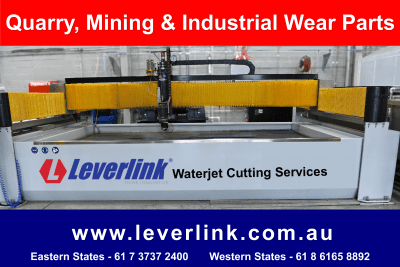Waterjet cutting solutions
Did you know that Leverlink provides state-of-the-art waterjet cutting services? Cost effective, reliable and produced to a high standard of workmanship, it’s the perfect solution to get your material precision cut.
But what is it and how does it work?
Let’s outline everything you need to know, starting with the basics.
The basics of waterjet cutting
Function
Waterjet cutting machines are used in industrial applications to cut just about any material. By using a jet of high-pressure water, sometimes mixed with an abrasive material such as garnet, the stream of water allows for precise and effective cutting.
Application
What can it be used for? Just about anything! Waterjet cutting is used across industries and in a wide variety of applications. Whether the material at hand is soft, such as foam, rubber or insulation, or hard like glass, stainless steel, stone, or aluminium, waterjets can cut through them all.
If you’re looking for a solution for a particular application, there are often specific waterjet stone cutting, titanium cutting or waterjet glass cutting machines. These custom specific pieces of equipment will ensure that you enjoy a reliable and efficient industrial cutting system.
Accuracy
Leverlink’s water cutting machinery offers highly accurate and precise cutting across many materials. In fact, our machines consistently provide cutting accuracies ranging from +/-0.0005” to +/-0.0015!
If you’d like more information about your specific intended use, feel free to contact the team here at Leverlink.
Technology
The technological process of a waterjet is actually quite simple. By generating pressure thanks to an ultrahigh pressure pump the water in the jet can be shot out at a phenomenal velocity. However, before the water is passed through the jet, it is filtered through an orifice that produces a waterjet stream as small and fine as a strand of hair.
To further improve cutting efficiency, an abrasive material can be introduced to the water, and the final steam is a mixture of the high-pressure jet of water and the industrial-level abrasive.
Types of waterjet cutters
There are two main types of waterjet cutters: the one uses pure water without mixing in any other material or substances and the other uses some form of industrial abrasive to help the jet of water to cut through the required material.
Pros and cons of waterjet cutting services
The Pros
There are many benefits to using waterjet cutting in your industrial application.
Affordability
An investment in a metal waterjet cutting machine (or any other type) or outsourced services, like ours here at Leverlink, is more affordable than you might think. Factoring in the savings on labour hours, ongoing maintenance, operational speed and productivity, it’s a highly efficient, financially and otherwise, solution.
No heat, no chemicals
Waterjet machines only use water and sometimes an abrasive material such as granite or garnet. They don’t produce excess heat or steam or harmful, polluting chemicals. When using the machine, you don’t have to worry about any of the secondary dust or smoke particles that can be associated with other cutting solutions.
Flexibility in application
From the types of material that can be cut to the ease with which the waterjet cutting machine can be used, you can enjoy unrivalled flexibility in its application and use. As mentioned above, you might want a specific waterjet system for glass cutting, for example, or you can opt for a versatile piece of technology that will be sure to keep up with your operations.
Precision
When it comes to industrial cutting, you need reliable precision. Waterjets are a popular method for this work, and for good reason. The easily controlled stream of high-pressured water provides reliability, accuracy, and peace of mind.
The cons
Costs
Waterjet cutting might offer a high return on investment, but it is still among the more expensive industrial cutting solutions. Of course, you get what you paid for in terms of efficiency, accuracy and versatility but you may need to consider your budget before moving ahead with waterjet cutting machinery.
Speed
When you compare waterjet cutting to other types of traditional machinery, it isn’t the speediest. Laser cutting, for example, can cut more centimetres per minute.
Clean up
While minimal cleanup is certainly required after using a professional machine for waterjet cutting, there can be some level of cleaning required.
Laser cutting vs waterjet cutting
One of the most common questions is whether waterjet cutting or laser cutting is best.
Laser cutting refers to using high-density energy beams, often produced through gas, that are directed into the material for precise cutting work. While laser cutting can be suitable for specialised applications or complex materials, there are a few reasons to opt for waterjet technology.
1. No marks
Despite being highly precise, laser cutting can sometimes leave burn marks on the surfaces being cut. With waterjet cutting, you can enjoy accurate cutting as well as smooth and clean surfaces afterward.
2. Better for thicker material
If you’re looking at cutting particularly hard and/or thick materials, it is recommended that you go for waterjet cutting. Between the high-pressure nature of the stream of water and its mixture of hard abrasive, waterjets can cut through all materials and objects.
3. Ventilation requirements
Laser cutting, dependent on the material being cut, can produce dust or smoke which can be toxic without the right ventilation.
Find out more
Interested in finding out more about our custom waterjet cutting services? Our friendly team of specialists are always ready and willing to help answer your questions, provide you with a no-obligation quote and find the perfect industrial cutting solution for you. Give us a call today on 07 3737 2400.



